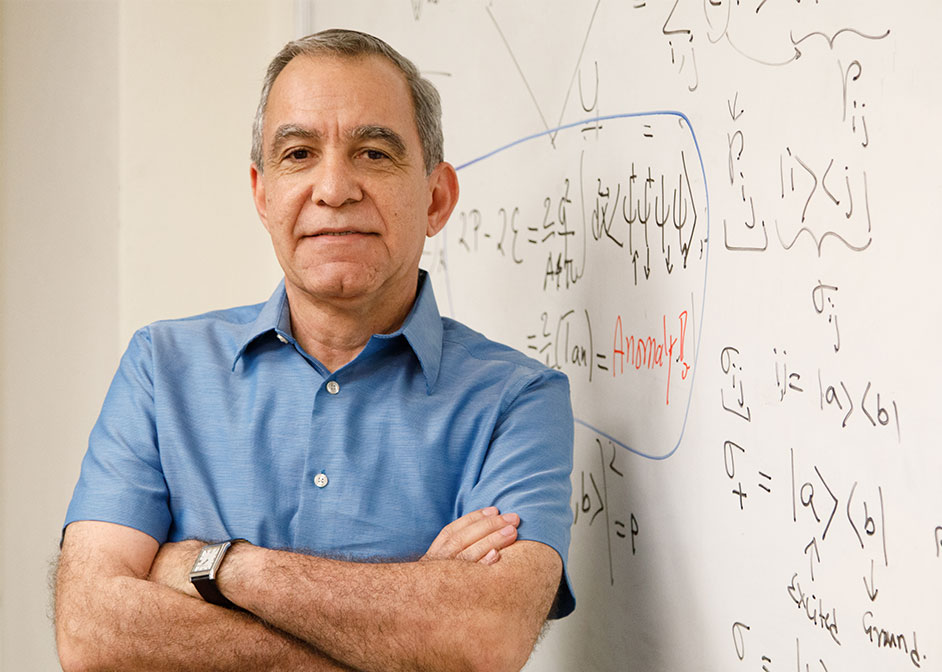Department of Defense Funds Theoretical Physics Research
Within the field of quantum physics, the past few decades have ushered in an era of experimental advances. The study of ultracold atoms is at the forefront of these developments.

Carlos R. Ordonez, University of Houston professor of physics, leads a theoretical physics group that works out mathematical structures for different systems of ultracold atoms. This work has been funded by a four-year, $527,000 grant award as the result of a merit competition administered by the Army Research Office.
“To study some of these systems, we are working on a conceptual framework based on the loss of scaling symmetry due to quantum effects, specifically quantum scaling anomalies,” Ordonez said.
Ultracold Atoms: Approaching Absolute Zero Temperatures
Ultracold atoms refer to gases of atoms that have been chilled to temperatures that approach absolute zero, which is the point at which molecular motion would stop. Although absolute zero has never been achieved, scientists have come close.
At these temperatures, atoms display some of the most spectacular effects predicted by quantum mechanics, such as Bose-Einstein condensation, when most of the particles in a gas occupy the lowest quantum energy state, producing macroscopically observable effects.
Studying the properties of ultracold atoms yields important insights about the nature of matter.
Theoretical Framework for Behavior of Ultracold Atoms
Ordonez’s research group works on establishing a theoretical framework for the behavior of highly diluted, ultracold, lower-dimensional gases, when quantum scaling anomalies appear. This research has included the work of multiple UH Ph.D. students, including Chris Lin (’15) and Wilder Daza (’19).
“We are developing a good mathematical description of the consequences of quantum scaling anomalies in the thermodynamic and other dynamical properties of lower-dimensional quantum gases,” Ordonez said.
His proposed framework combined ideas from atomic and particle physics, which led to interesting results.
Same Mathematical Descriptions for Different Systems: From Particle Physics to Ultracold Atoms
1D systems are when particles move in only one dimension. For example, a particle can move from left to right but cannot move around another particle. A 1D system behaves differently from a 2D system or a 3D system, where particles have more latitude to move around.
Nevertheless, Ordonez and his team found deep mathematical similarities between 1D
and 2D gases that were far from obvious.
“We solved a 1D system by relating it to a 2D system, because they share the same
classical symmetry, and a common quantum anomaly structure. My background in theoretical
particle physics served me well in using symmetry arguments to identify and develop
a mapping between seemingly very different systems in different dimensions,” Ordonez
said.
The Importance of Collaborations
Within the last four years, this research has resulted in numerous publications, in journals such as Physica A, Physical Review A, Physical Review Letters, and Modern Physics Letters A. For the paper published in Physical Review Letters, one reviewer noted that “this paper opens a significant new area of research both in the theory of quantum gases and in their experimental realization with ultracold gases.”
“More than the research, the collaborations are important. Putting a group together, with the younger scientists learning, is very rewarding. I think that is as important as the research itself,” Ordonez said. “These results would not have been possible without the foresight and vision of the Department of Defense, which allowed me the opportunity to be creative and merge ideas from particle and atomic physics. I cannot thank them enough for this.”
Grant awards are administered by the Army Research Office under the policy and guidance of the Office of the Under Secretary of Defense for Research and Engineering. The Army Research Office is an element of the U.S. Army Combat Capabilities Development Command’s Army Research Laboratory.